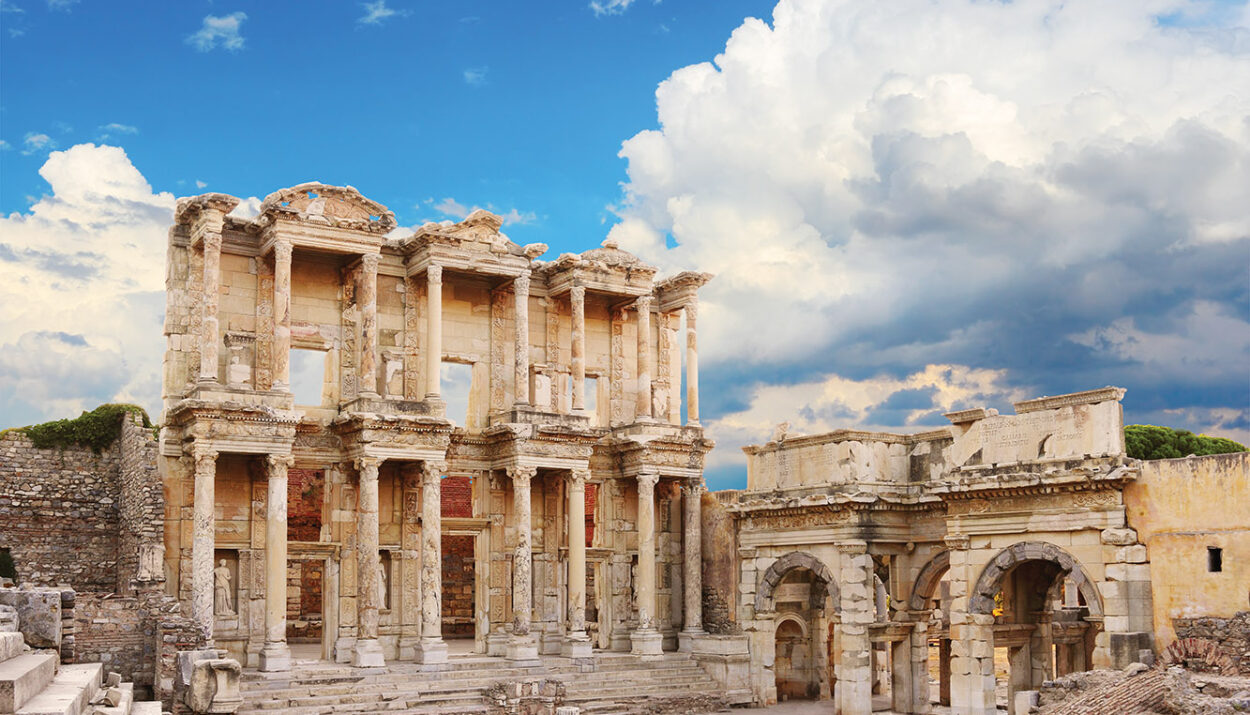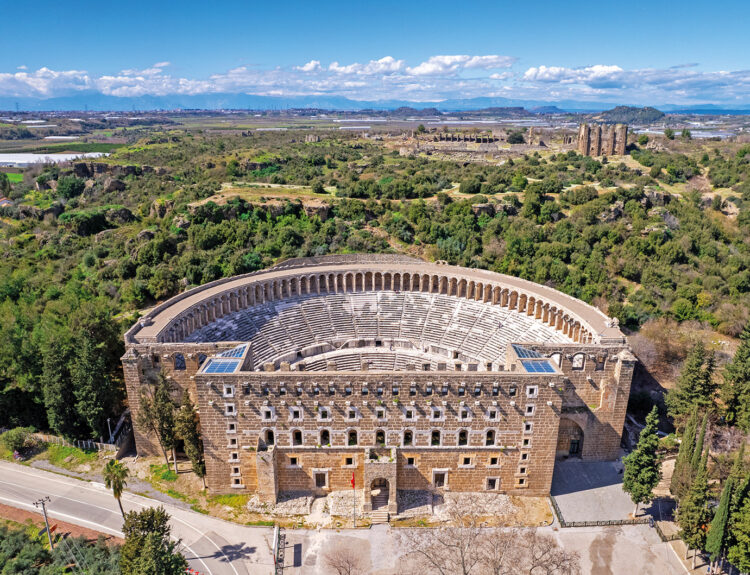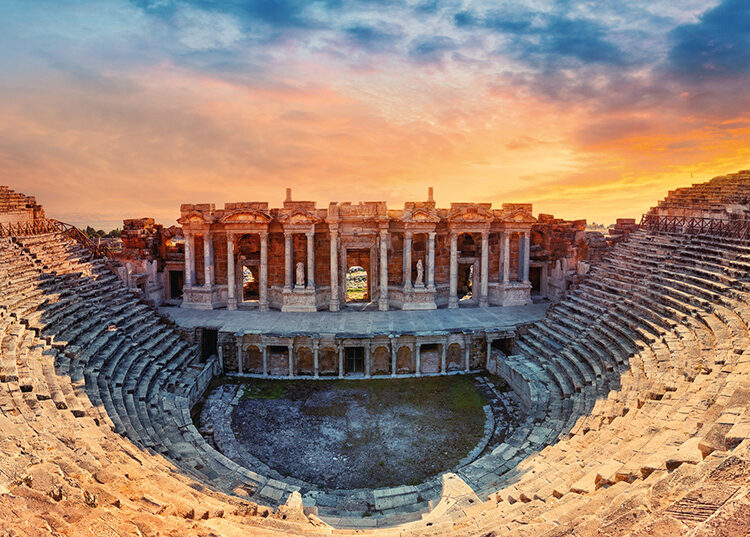Ancient City of Ephesus is a treasure trove for history and culture enthusiasts, offering an open-air museum experience. Home to the ruins of the Temple of Artemis, one of the Seven Wonders of the Ancient World, the majestic Library of Celsus, and the impressive Great Theatre, Ephesus immerses visitors in the depths of history. Its rich architecture and historical artifacts make it one of Türkiye’s premier tourism destinations. With every step revealing traces of the past, this extraordinary city remains a captivating attraction for history lovers.
Ancient City of Ephesus, a significant archaeological site from the Ancient Greek and Roman periods and one of Türkiye’s most visited tourist destinations, is located in the Selçuk district of İzmir. Especially prominent during the Ancient Greek and Roman eras, Ephesus has hosted numerous civilizations throughout history. Ephesus is currently listed as a UNESCO World Heritage Site and attracts millions of tourists each year. The diverse cultures and civilizations that have thrived in Ephesus throughout history are clearly reflected in the city’s architecture and ruins. This makes Ephesus of immense significance both as a historical and cultural heritage site.
Ancient City of Ephesus, founded as early as the 10th century BC, was established by settlers from Greece. The city initially developed as a coastal settlement. The original site of the city was located about 3 kilometers south of present-day Ephesus, near the capital of the Arzawan Kingdom, Apasa.
In the 7th century BC, Ephesus came under the control of the Lydian Kingdom. During this period, the construction of the Temple of Artemis, one of the city’s most significant structures, began. In the 6th century BC, Ephesus was conquered by the Persians, and with Alexander the Great’s liberation of Anatolia from the Persians, the city entered the Hellenistic Period. After Alexander’s death, the city came under the control of his general Lysimachus. In the 3rd century BC, Lysimachus rebuilt the city, moving Ephesus to its current location. Lysimachus also strengthened the city’s defenses by constructing extensive walls.
During the Roman Empire era, it became a major center of trade, culture, and religion
During the Roman Empire era, Ephesus became the capital of the Asia Province and experienced its most flourishing period. The city emerged as a major center of trade, culture, and religion. Key structures from the Roman era include the Library of Celsus, the Great Theatre, and the Temple of Hadrian. The wealth and power of the Roman Empire brought noticeable prosperity to Ephesus. Positioned along the trade routes between the east and west of the Roman Empire, the city enjoyed significant economic advantages. Additionally, Christianity began to spread during this time, and Ephesus became an important center in the history of Christianity.
Construction of the House of the Virgin Mary
After the division of the Roman Empire, Ephesus became part of the Eastern Roman (Byzantine) Empire. During the Byzantine period, the city continued to be a religious center, with important Christian structures such as the House of the Virgin Mary being built. However, the accumulation of alluvium from the Menderes River filled the harbor and cut off the city’s connection to the sea, leading to a gradual decline in its significance. Additionally, earthquakes and invasions accelerated the city’s downfall. By the end of the Middle Ages, Ephesus was completely abandoned and forgotten for centuries. Discovered by European archaeologists in the 19th century, Ephesus began to be excavated from that time and has since become a major archaeological site.
One of the seven wonders of the ancient world: the Temple of Artemis
The Temple of Artemis, considered one of the Seven Wonders of the Ancient World, was one of the most magnificent structures of Ephesus. Completed in 550 BC, the temple was dedicated to Artemis, one of the most powerful goddesses in Greek mythology. It served not only as a place of worship but also as one of the largest centers of art and trade of its time. With its 127 marble columns and splendid architecture, the Temple of Artemis was a symbol of cultural and economic power. Although the temple was largely destroyed by a series of devastating attacks and natural disasters, its ruins still reflect the engineering marvels of the ancient period and offer visitors a chance to trace the remnants of the past.
One of the greatest libraries of the ancient world
The Library of Celsus is one of the most impressive and well-preserved structures of the Ancient City of Ephesus. Built in 117 AD by the son of Roman Senator Tiberius Julius Celsus Polemaeanus in his honor, the library was renowned as one of the largest libraries of the ancient world, housing over 12,000 manuscripts at that time. The façade of the library is considered one of the finest examples of Roman architecture from the period. Among the four main columns on the façade, statues representing the goddesses of “Wisdom” (Sophia), “Virtue” (Arete), “Intelligence” (Ennoia), and “Knowledge” (Episteme) are displayed. These statues symbolize the intellectual function of the library and the virtues of its patron.
Travel back to antiquity at the Great Theatre
With a capacity of about 25,000 spectators, the Great Theatre is one of the largest structures in Ephesus, showcasing both ancient social life and the grandeur of Roman architecture. You can walk the stage and imagine the area where performances and spectacles took place in ancient times.




